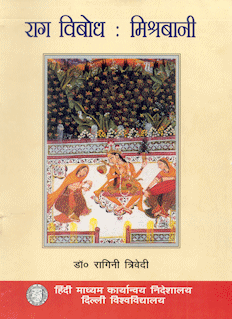Book Review: Ragini Trivedi's Raga Vibodh: Misrabani

Book Review: Ragini Trivedi's Raga Vibodh: Misrabani |

|
By Dr. Suwarna Tawase |

Available for purchase online.
Hindi Madhyam Karyanvaya Nideshalaya serves a special need of students -- availability of authentic text in Hindi. Over the years, it has published books of celebrated authors originally written in other languages translating them to Hindi. But in its commitment to make quality text avail bale to students at affordable price, it has also published dictionaries like Urdu-Hindi-English in two volumes. It has gradually evolved a tradition to bring out new volumes on Hindi day. Extending its scope to first hand creation of text in Hindi on 14th September 2010, it released six new books. Raga Vibodh: Misrabani holds a special place as this was the first publication of musical notations by the organization. Not only does this book portray the maturing of Indian publishing through use of UTF-8 font-script, it also heralds a new era in music scholarship -- writing music on computer as text. In the publisher's note, Director of Hindi Madhyam Karyanvaya Nideshalaya states that the author, inspired by father Dr. Lalmani Misra in turn inspires son Terence to create the Digital Bhatkhande notation system so germane to documentation of musical compositions in present age.
It was pointed out by an eminent professor that apart from above, the book also makes innovative use of identifying each composition through a numbering system. Thus Comp. No. 305 indicates fifth composition of third Raga in book, Bhupali. Similarly 512 indicates twelfth composition in fifth Raga Vrindabani Sarang. Even Tan and Toda-s are easily identifiable with 3.16.3 (third 16 matra composition in third Raga) and (7.#.3) indicating third Toda in seventh Raga. Such a system would help students in pinpointing a particular composition in discussion and study. I think books carrying compositions for string instruments have rarely been published in past two or three decades. A whole generation had to content itself with only recorded music. It is only when one goes through a well presented volume of compositions that the value of notation is realized. A recording serves the ear, a compostion appeals to mind. For a learner, it is always easy to refer to a written composition than to find the phrase in recording of a recital.
The introductory chapter briefly but clearly explains fundaments of India music. In an easy fluid manner the author elucidate basic terms, Nad, Swar, Swar-sthan, Saptak, Raga, Vadi, Vivadi, Anuvadi, Meend, Kan, Murki, Soot, Ghasit, Jati etc. The nature and variety of Tan, Tal are again illustrated in an interesting manner. A much needed dialogue on internet usage specifically in the area of Classical music makes this volume valuable. Anyone who chooses to follow the links given shall have recourse to online learning as well.
The nine Raga-s selected from four Thaat-s (Bilawal, Kalyan, Khamaj & Kafi) can be played without changing the position of frets -- Bilawal, Yaman, Bhupali, Khamaj, Vrindabani Sarang, Bihag, Kafi, Des, Tilak Kamod. Each Raga is clearly explained under common heads -- sonant, consonant, time, catch phrase etc. The author provides reasons for mode and characteristic behaviour of Raga referring to earlier scholars, accepting or refuting popular belief. Often, compositions carry a short pointer about its specialty or some characteristic. For example in Composition 206 (Teental Madhyalaya in Yaman) the note says, "In this Gat the Pancham on 14th matra is to be played with force on 'Da'. This would distinguish the Gat. Although this 9th matra Gat appears simple the unusual weight of Mizrab often produces charismatic effect."
Almost ten to twelve compositions (15 in Vrindabani Sarang) of each Raga have been given with Sthayi, Manjha and Antara. The compositions are graded. The first 3-5 simple, next three or four challenging and the final couple or so of extreme complexity. These final compositions are meant for stage performers.
Apart from list of useful books, there is another list about eminent academicians and music departments. If more details (email, telephone numbers etc.) were to be included, the book would have been of service in another dimension as well. An index of terms and a glossary containing explanation of terms in English would enhance value of future editions. Priced only Rupees two hundred, the five hundred page book is sure to appeal to students of music as well as to artistes. One ends up paying under two rupees per composition besides gaining insight into Indian Classical Music.
Browse collection or Order on Omenadshop.
Suggested:
Sitar Compositions in Ome Swarlipi Read Review by Pt. Omprakash Chaurasiya
Bharatiya Sangeet Vadya on wikipedia
Bhāratīya Shāstrīya Sangīt: Shāstra, Shikshan Va Prayōg
List of books on music.
Musical tracks.
Annotated compositions.